How to Poach a Pear – Pere martine al Toscano Rosso
How to Poach Pears in Red Wine
If peaches are the Queen of Summer fruit, then surely pears reign in Winter. Poached Pears, served whole, halved or sliced, delight family and guests. Bart walked into the kitchen the other night, and I shooed him out saying I had a surprise dessert for him. (By the way, that is a really good way to get people out of the kitchen – works better than anything else I have tried.) I poured Creme Anglaise on a plate, placed a jewel of a poached pear in the center, decorated it with some poaching syrup, and presented it to Bart. His face lit up. This one is a winner.
Poached pears are especially welcome now as we look for lighter desserts. Bosc and D’Anjou are the pears most often recommended for poaching, but Bartletts, red d’Anjou and Comice are my favorites. Select firm, unblemished and slightly under ripe fruit. Pay special attention to the stems of the fruit you buy; look for nicely formed ones, and be certain they are firmly attached.
The poaching liquid can be anything you like – white wine, red wine, Port or fruit juice, but it will always be sweetened with sugar. In fact, fruit is often poached in simple syrup alone. The poaching liquid itself can be flavored with vanilla bean, citrus zest, cinnamon sticks, cloves, allspice, star anise or other spices.

I used a Mazzoni Toscana Rosso 2007, a stunning blend of San Giovese and Merlot. Although a Super Tuscan might at first seem an unlikely candidate for poaching, the sugar and spices in the poaching liquid, particularly the cinnamon and star anise, bring out the berry and licorice in this wine as well as complementing the notes of balsamic. The poaching liquid itself is quite a wonder, reducing to a luxurious elixir, redolent of berries, vanilla and spice.
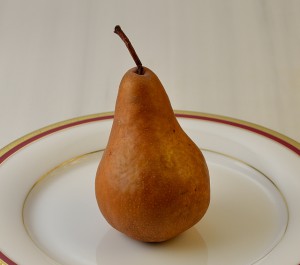
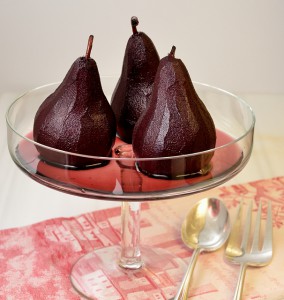
There are several ways to present this dessert. You can serve the pears whole, standing in a pool of slightly thickened poaching liquid or Creme Anglaise. Try slicing the pear in half lengthwise and lay it flat or fanned on a plate. Alternately you can serve slices. It is up to you, but the most striking presentation is undoubtedly a pear served whole. Peel the fruit carefully. Presentation is a big part of this one. And NEVER pick the fruit up by its stem. You are liable to lose it, the stem that is.
The best thing from the cook’s standpoint, is that the components of this dessert can be made ahead, the pears two days, the Creme Anglaise, three. Note that the pears featured here were shot at various points; some just after poaching, and others up to 48 hours later. The darker they appear, the longer they remained submerged in their poaching liquid. Buy some pears and wine and get busy!
How to make Creme Anglaise
Creme Anglaise is one of those “must have in your repertoire” sauces. Traditionally made with milk only, I like to exchange some of the milk for cream to make a thick voluptuous sauce. Also known as stirred custard, this blend of milk, eggs, sugar and vanilla starts life as a dessert sauce and really is a kitchen workhorse. As is, it forms the base for ice cream; add gelatin and whipped cream and it morphs into creme bavarois. Add flour as you whisk the eggs and sugar, and you have pastry cream. There is just no end to its uses. Likewise the flavoring possibilities are boundless. Vanilla is a must, either extract or a split bean, but mint, liqueurs and spices are all possibilities. While a split vanilla bean is cooked along with the Creme Anglaise from start to finish, extracts and liqueurs must be added at the end, off the heat, to avoid adulteration of their flavors.

To master this sauce, you must learn how to tame an egg. Keep in mind that egg yolks are delicate creatures. Heat them too long or too briskly, and you will wind up with scrambled eggs. Guaranteed. For this reason, many cooks use a double boiler. You can however, cook this over direct heat, just make sure it is gentle, never above medium, and stir, stir, stir, scraping the sides and corners of the pan as you work.
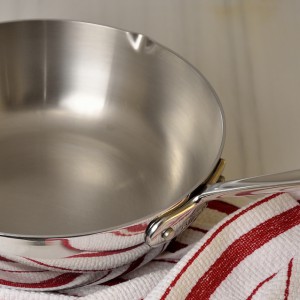
If you have a pan with sloping sides, such as the one shown, custards and sauces are the place to use it. Lacking the sharp angles of standard pans, there is no place a whisk or spatula will miss. BEFORE USING A PAN LIKE THIS FOR THE FIRST TIME, FILL IT WITH WATER AND PRACTICE POURING FROM IT. No kidding. This style saucepan is weighted differently than a standard straight sided one, and if you are not ready for it, you may experience difficulty controlling the pan as you pour its contents into another vessel. The voice of experience is speaking.

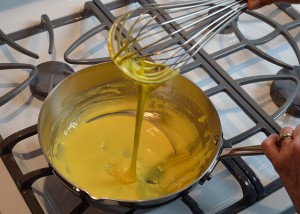
To begin, scald milk and cream in microwave (about 2 to 2 ½ minutes.) Meanwhile, in a medium saucepan, WITH THE HEAT OFF, whisk eggs and sugar together until very light. Your goal here is to dissolve the sugar. A note of caution: once you add sugar to eggs or vice versa, you must immediately begin mixing. Let the sugar set on the eggs, and the eggs will be “burned” – small, hard lumps of protein will form. Irretrievable. You must begin again.
Further, to avoid shocking the eggs and to reduce the chance of curdling when you place them over the heat, you must first temper them. To accomplish this, whisk sugar and eggs together, and then very slowly add hot dairy mixture, whisking all the while, gently raising the temperature of the eggs.
Once you have added all the dairy, stir the mixture constantly with either a whisk, spatula or wooden spoon. Avoid creating bubbles or foam. At about 140-145 degrees F. (60-62 degrees C. ) steam will escape from the surface of the custard. As you continue, the surface will become smooth, and you are now quite near the end, 170-175 degrees F. (77-79 degrees C.) Keep in mind there is a point of no return for this sauce, and it is 180 F. (82 C.) Heated above that, the sauce is overcooked and must be discarded. This process will take from 5 to 8 minutes. A word to the wise – use a wooden handled utensil. A metal one will tend to get hot.
Let me add that in classic French cuisine, the eggs and sugar are whisked not in a saucepan, but in a mixing bowl. The milk is scalded in a saucepan, and about 1/3 of it is slowly whisked into the egg and sugar mixture, then the milk, egg and sugar mixture is returned to the saucepan containing the remainder of the hot milk. I prefer the microwave method.
There is another technique I must mention, the veritable commando method of Mme. Madeleine Kamman, Goddess of the World of Cookery. Counter to what I have just told you, she cooks her Creme Anglaise over high heat, completing the process in about 1 minute. It works beautifully, but requires an experienced eye with the facility to recognize the various stages of cooking. A key to success with her method is to avoid overbeating the eggs and sugar at the outset. Do that, and you will have so much foam it will have no time to reintegrate into the custard mass, and the mixture will not cook properly. Follow the rules, mine or those of Mme. Kamman, and you will have one of my favorite delectations. By the way, I always make extra because I drink it. Really.
Creme Anglaise
makes about 2 cups
1 cup whole milk
3/4 cup heavy cream
4 large egg yolks
1/3 cup granulated sugar
1 teaspoon vanilla extract
Prepare an ice bath, and have ready a strainer set over a stainless steel bowl. Pour milk and cream into microwave safe measuring cup, and microwave until just under the boil, about 2 to 2 ½ minutes. Meanwhile, OFF THE HEAT, whisk eggs and sugar in medium saucepan until thick and light in color. Slowly pour the hot milk and cream into eggs, whisking constantly. Cook over medium heat, stirring or whisking very gently but constantly until mixture coats the back of a spoon, or a candy thermometer reads 170-175 degrees F. (77-79 degrees C.), but no higher than 180 degrees F. (82 degrees C.)
Remove from heat and strain into clean stainless steel bowl. Add vanilla, and set over ice bath to cool, stirring occasionally. Pour into glass storage container. Place plastic wrap directly on surface to prevent formation of skin. Refrigerate up to 3 days.
For the pears
1 whole pear or 1/2 pear per serving
1 bottle Mazzoni 2007 Toscana Rosso
1 cup water
1 cup granulated sugar
1 6 inch cinnamon stick
1 vanilla bean, split, seeds scraped into poaching liquid
2 star anise
Cut a piece of parchment the diameter of the saucepan, and cut a ½ inch circle out of the center. Set aside. Add wine, water, sugar, cinnamon stick, vanilla bean and star anise to 4 quart saucepan. Place over medium heat, stirring occasionally until sugar has dissolved and mixture has come to a boil. Reduce heat to very gentle simmer.
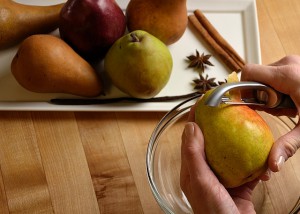
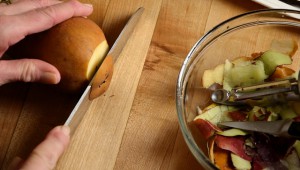
Meanwhile prepare fruit. If you plan to serve the pears whole, cut a slice off the bottom to provide a stable platform if they will not stand on their own. You may omit this step if you plan to serve pears halved lengthwise or sliced. Draw the vegetable peeler down the fruit to peel, being careful to leave the stem intact, especially if you plan to serve the fruit whole.
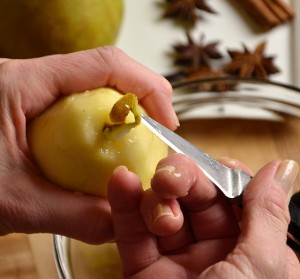
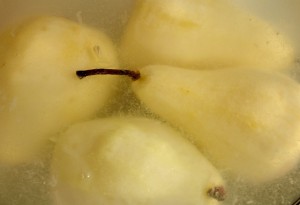
To remove the last little bit of peel that resides in a circle around the stem, carefully draw a small paring knife around the stem. The peel will lift off in a complete circle. If you will be poaching halves of pears, cut out tough inner core and scoop out seed pocket using a melon baller. Place prepared pears in a bowl of cool water into which you have squeezed the juice of 1 lemon. This acidulated water will prevent the fruit from oxidizing.
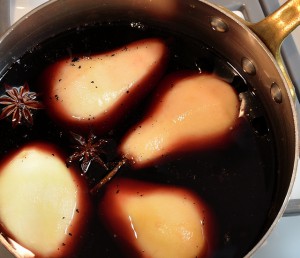
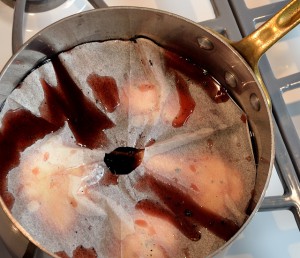
Gently place fruit in the simmering poaching liquid, and cover with the circle of parchment. The liquid may not completely cover the fruit. Not to worry. That’s what the parchment is for. Just carefully turn the fruit every few minutes, reaching under the parchment with a rubber spatula or other soft tool, taking care not to nick the pears, keeping the liquid at the barest simmer. Pears should be ready at about 25 to 40 minutes. To check for doneness, insert a sharp paring knife into the bottom of the fruit. It should slide in with a minimum of resistance.
Remove from heat and transfer pears to glass bowl. Pick them up carefully – they are easily dropped. Pour poaching syrup over pears, making certain they are submerged. Place fresh parchment over pears, and cover with plastic wrap. Refrigerate up to 48 hours.
Don’t laugh – beauty tip. I am betting you are going to make these for company. The poaching liquid can stain your hands (your clothing too, by the way.) Be very careful or wear gloves. I just had to issue the disclaimer.
To serve pears
Over medium heat reduce poaching liquid to a syrupy consistency. Pour Creme Anglaise on serving plate. Position a whole or half pear on plate.
Drizzle poaching syrup over Creme Anglaise to make a decorative design OR get ready for Valentine’s Day by making a ring of interconnected hearts. To make the ring drop dots of reduced poaching syrup evenly just inside the edge of Creme Anglaise. Draw a paring knife through dots in one continuous circular motion, connecting them all to form a ring of hearts. Serve at once.
A note to the concerned cook: If you do not have a candy thermometer and are concerned about egg safety, I recommend the use of Davidson’s Safest Choice Eggs. The eggs undergo in-shell pasteurization which removes the threat of Salmonella.
Note: You can click on any picture for a larger image, and to see a slide show with even more pictures!
I have no affiliation with any product, manufacturer, or site mentioned in this article.
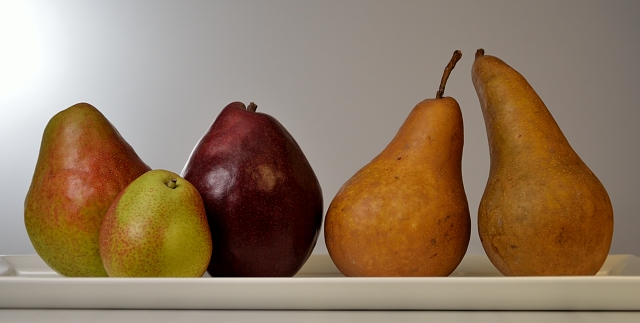
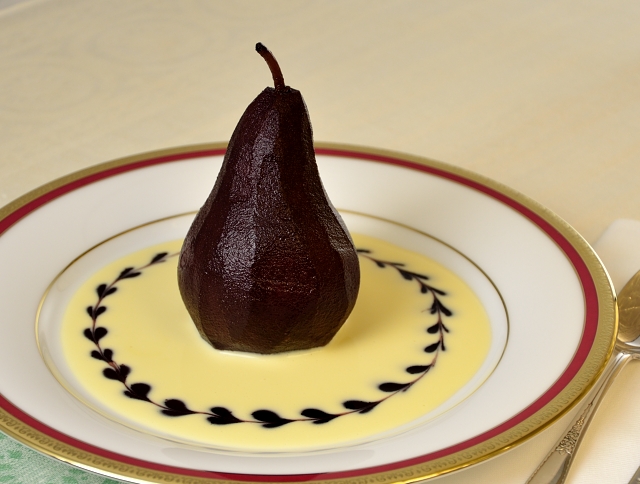
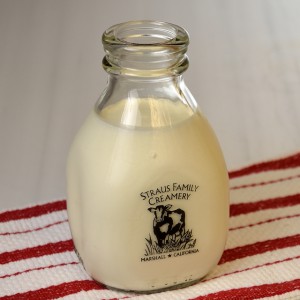
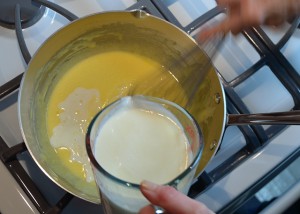

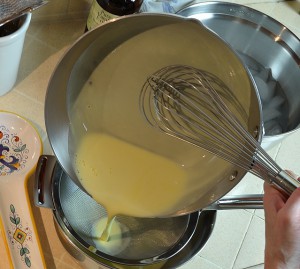
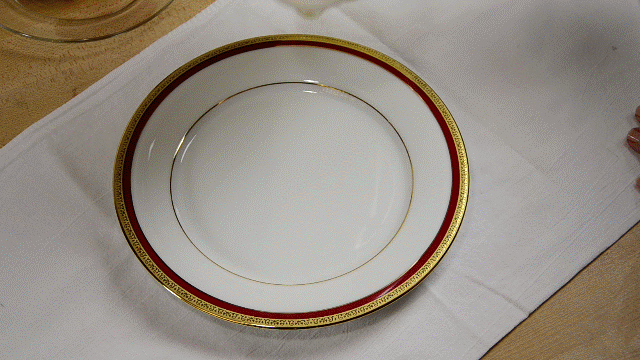
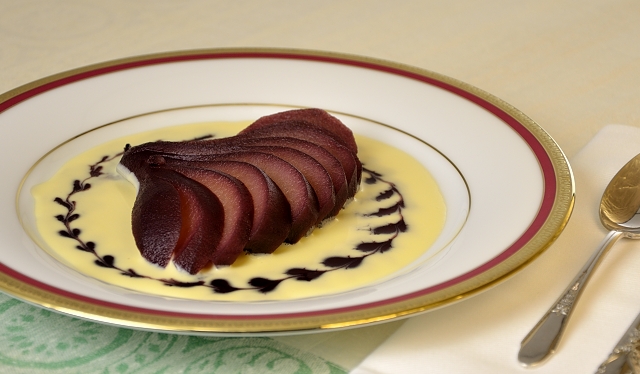
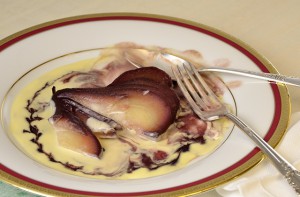


Sunday, January 29th 2012 at 5:47 am |
Adri – beautiful as always. I wish I could do that with pears, just amazing. Complimenti! Trisha
Sunday, January 29th 2012 at 7:33 am |
Hi Trisha,
Well I will let loose with my standard but sincere reply. You can do this. Honest. Like so many things, at first glance it can seem like a big production, but in practice is rather easily accomplished. People are always wowed by this dessert, and since you can do it ahead, it is simple for the hostess. Try it. You really will be pleased. If you have questions, please email me. I would be happy to help. Thanks for stopping by, and for taking a moment to comment.
Sunday, January 29th 2012 at 4:05 pm |
Absolutely spectacular! We are inspired. Lovely photos, and very clear directions. Can’t wait to try them!
Sunday, January 29th 2012 at 5:58 pm |
Ciao Cara,
Thank you so much for the kind words. I have always thought of poached fruit, pears in particular because of their graceful form, as the most elegant dessert around. Add the Creme Anglaise and one is home free. It is a particularly nice dessert as no particular skills are required, not to mention the do-ahead factor, always a plus. Dinner guests always enjoy them, especially if they have never had them before. Bart’s favorite poaching medium is Port, but he didn’t grouch when I gave him this version. All the best to you, and thank you for stopping by my site.
Sunday, January 29th 2012 at 11:12 pm |
Wow, Adri, those hearts are so pretty, and making them looks surprisingly easy. Have to try this.
Monday, January 30th 2012 at 6:53 am |
Hi Mette,
Thank you for the compliment. The hearts are easy to do. Thicken the poaching liquid by reducing it over heat, and with a bit of practice you will perfect the technique. It is remarkably simple. When you try it, please send me a photo. I will display it in my Readers’ Gallery. We are certainly in very good company this week on Food Lover’s Odyssey, aren’t we! Kathy has one of the most remarkable sites I have ever seen. Thanks for stopping by The Front Burner.
Monday, January 30th 2012 at 9:42 am |
I messed up on the design in the sauce but it was still an awesome dessert
Monday, January 30th 2012 at 1:03 pm |
Ciao Anthony,
Well, I say, how bad can it have been? Once you take one bite, the design is shot anyway. Think of this attempt as practice for a Valentine’s Day dessert. Thanks for stopping by and for the report from your kitchen.
Monday, January 30th 2012 at 2:20 pm |
Adri, thanks for your kind comment on my blog. will keep it short since I’m typing one-handed, but I just have to say ‘complimenti’ on this lovely post. Poached pears are one of my fave desserts, and I love your decorative flourish.
Monday, January 30th 2012 at 8:59 pm |
Ciao Domenica,
Thank you for the kind words. Poached pears are terribly elegant, aren’t they? Far more elegant than a bandaged hand! Stelle barbare! I just cringed when I read your post. I hope it is not too painful, and I hope you are better very soon.
Tuesday, January 31st 2012 at 7:21 am |
Looks quite delish. I have a surprise for you. when you have a chance check out my blog http://www.questfordelish.blogspot.com
Tuesday, January 31st 2012 at 8:16 am |
Well oh my goodness! I did go to your very delish blog, and thank you for the Liebster Award. It is a pretty cool concept. I am rather new at this, and I certainly do appreciate the recognition. The nicest part is supporting one another and giving tips along the way. Thank you so much, and thank you for you compliments on my post. Next up on your “to learn” list simply must be poached pears. ‘Tis still the season. And may I respectfully request a photo of your finished product (or anything along the way, really) for my Readers’ Gallery? I’ll be waiting…
Tuesday, January 31st 2012 at 7:29 am |
I love pere al vino rosso but never have I attempted this level of elegance and perfection in presentation! It’s quite a sight to behold. Complimenti!
Tuesday, January 31st 2012 at 8:23 am |
Benvenuto,
Thank you so much for the kind words. That is very high praise coming from you. Pere al vino rosso are such an elegant dessert. I could not resist going the extra mile. And I will add that you ought to try the decoration. It is relatively easily mastered, and the good news is one can always eat one’s creations that fall short of perfection. Thank you for stopping by my site. I hope you return often.
Tuesday, December 15th 2015 at 12:32 pm |
I love the addition of Creme Anglaise to a poached pear dessert! YUMMY!!
Wednesday, December 16th 2015 at 11:46 am |
Hi Pam,
Thank you. I just love poached pears, and I am pleased to hear that you like my take on this classic dessert. Warmest wishes to you and yours for a wonderful Christmas and a very happy new year!